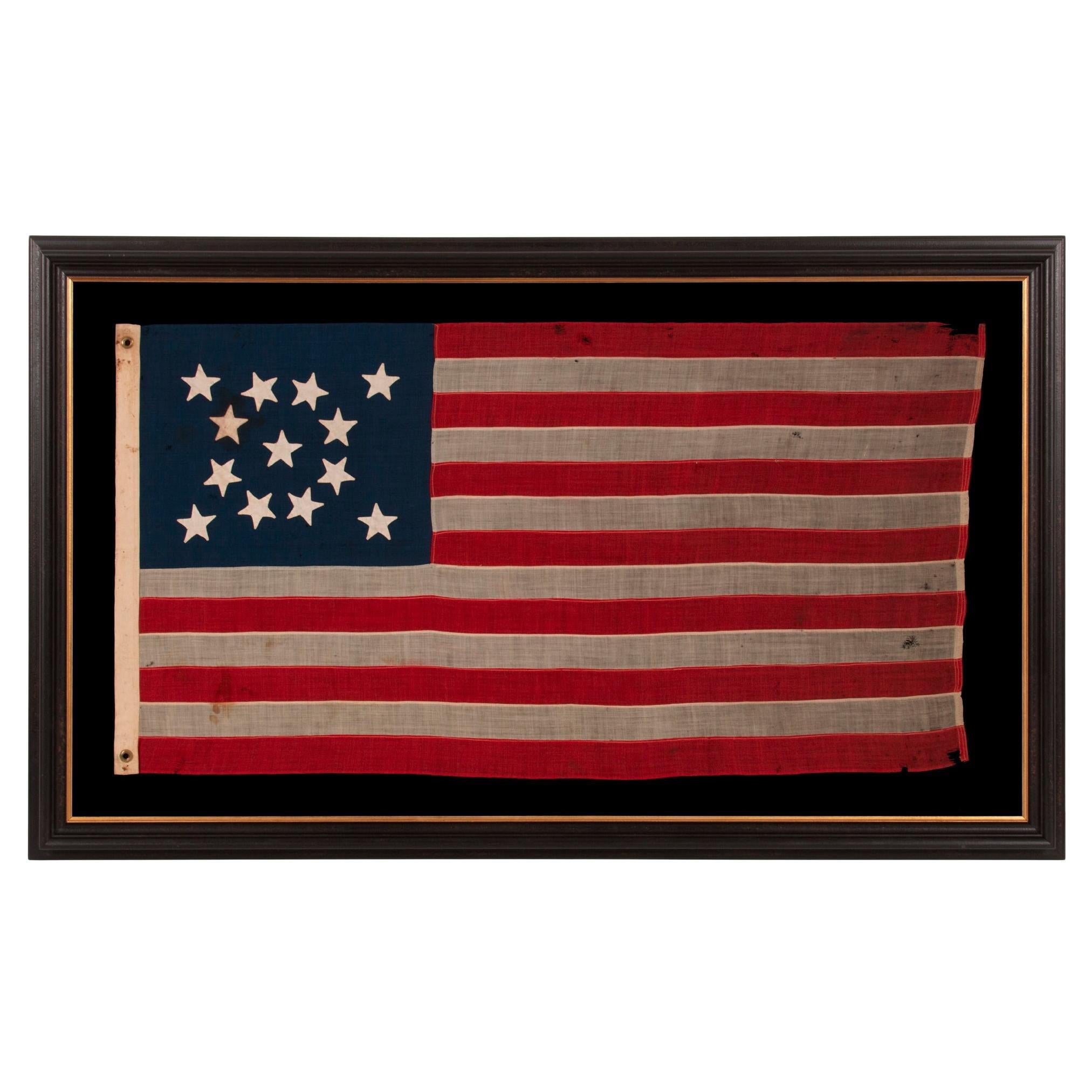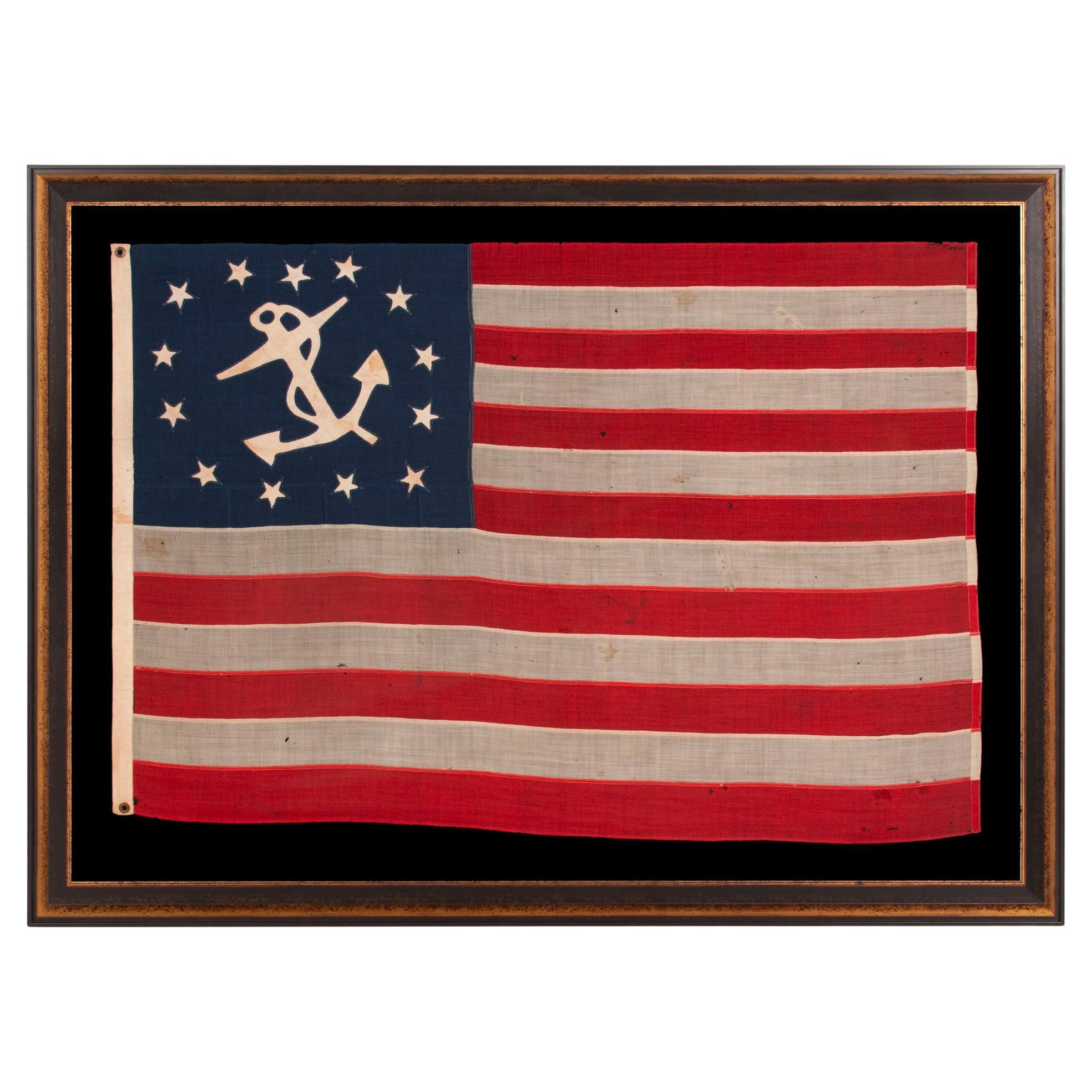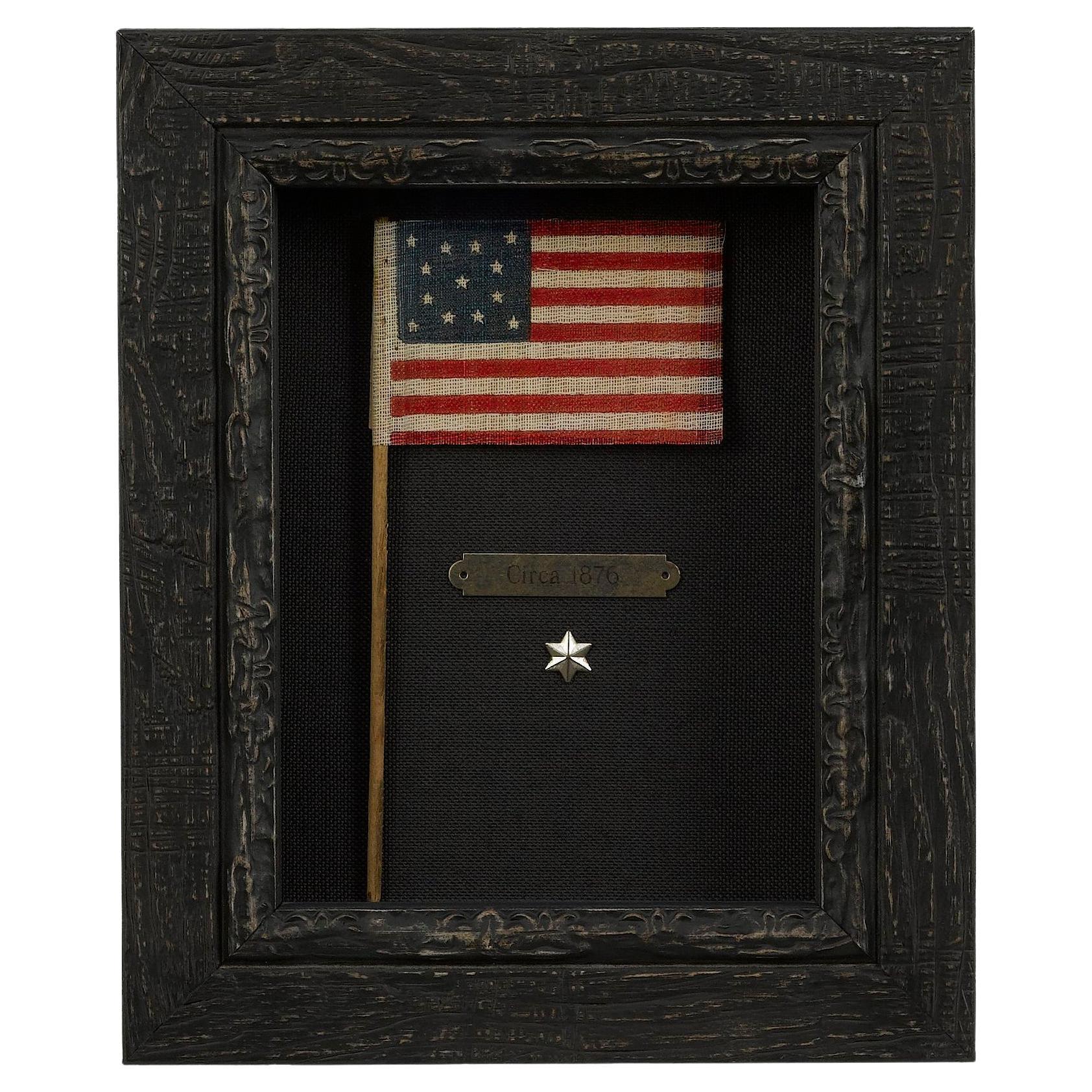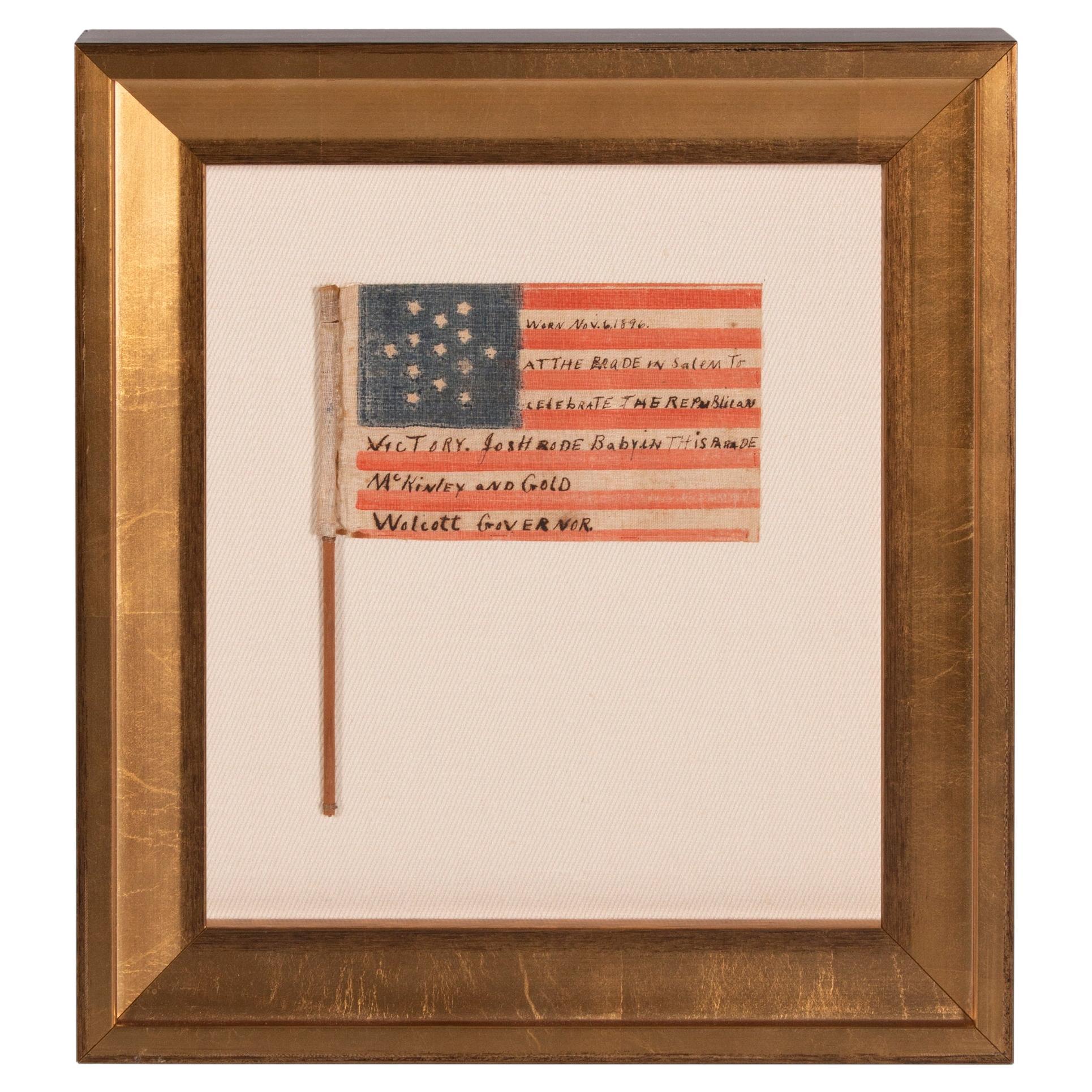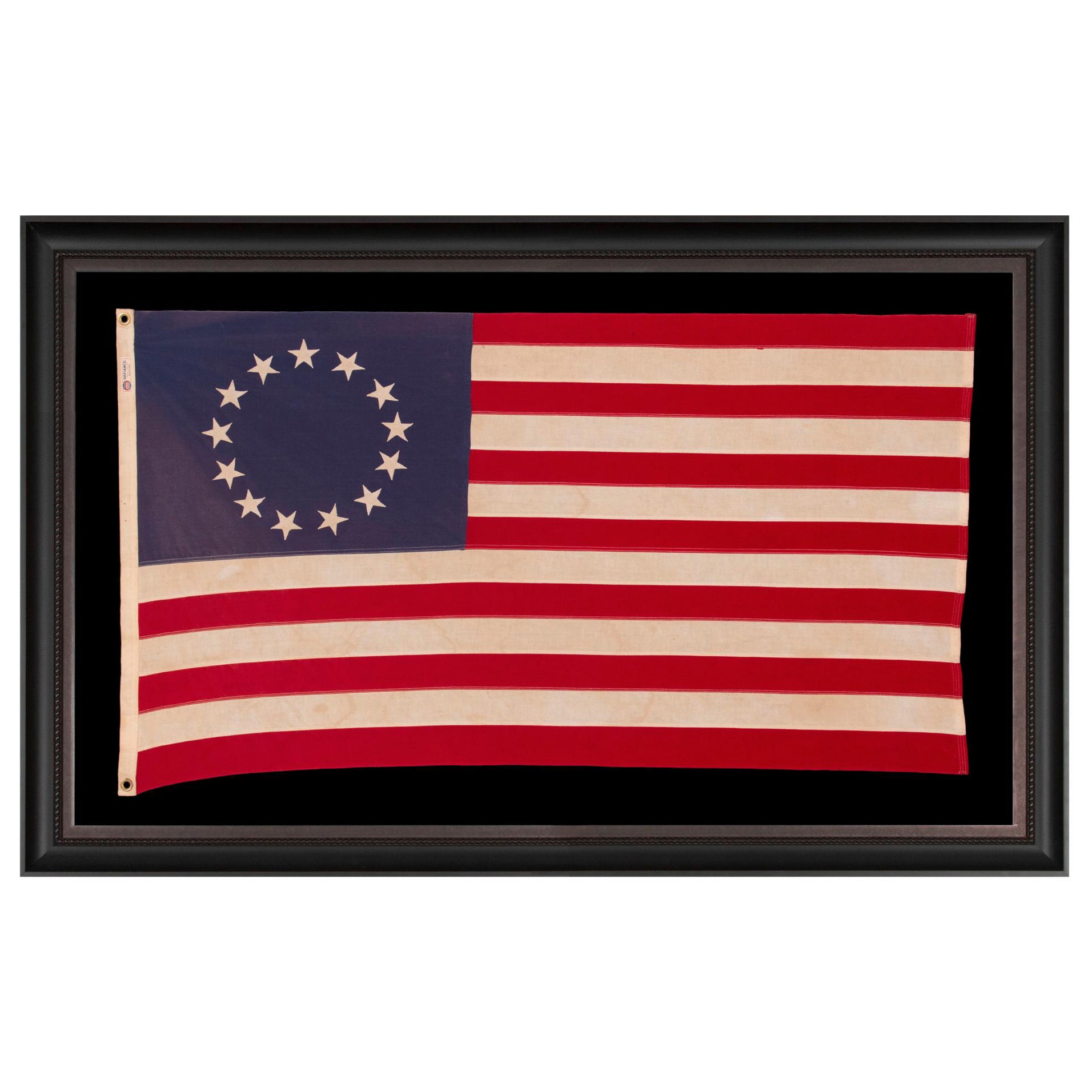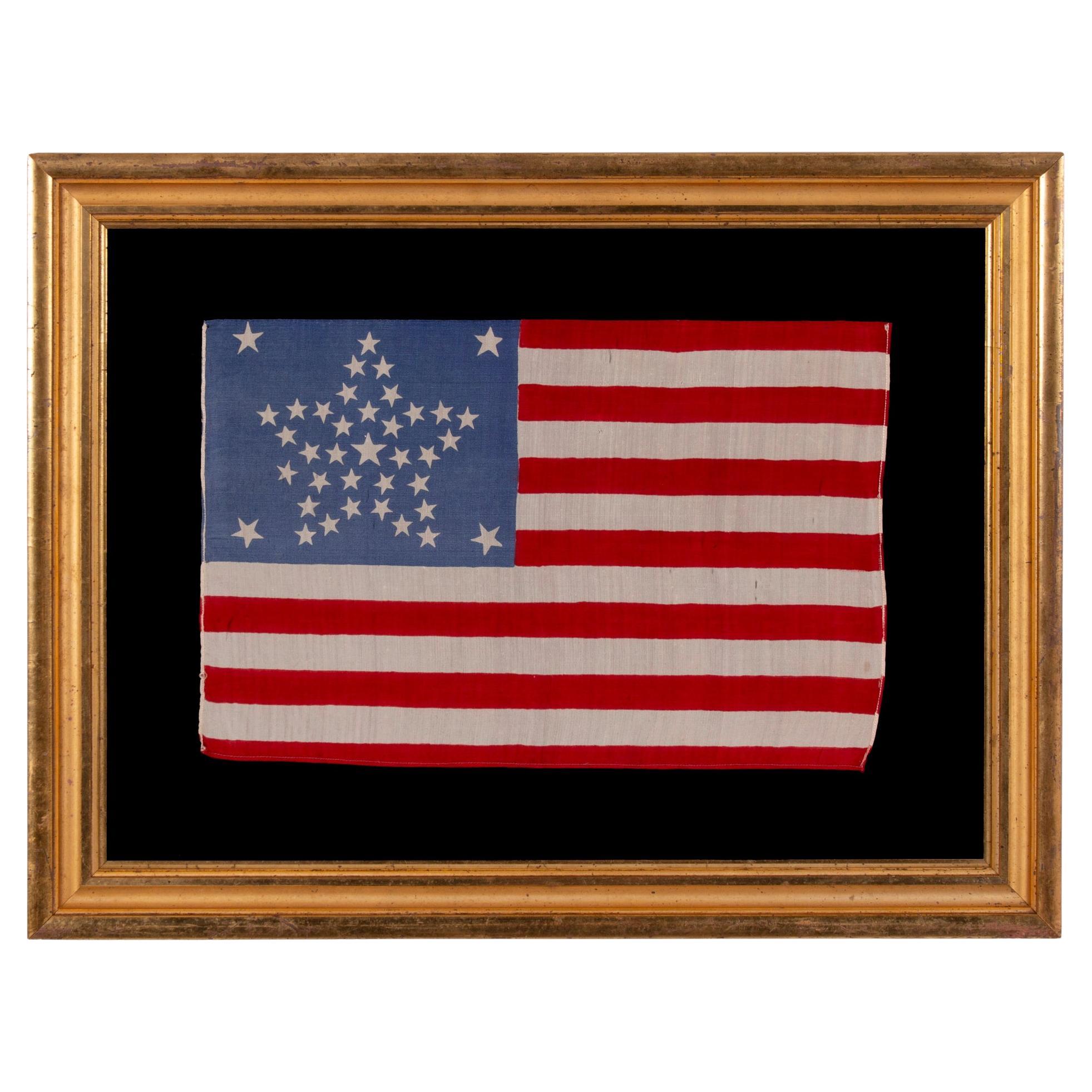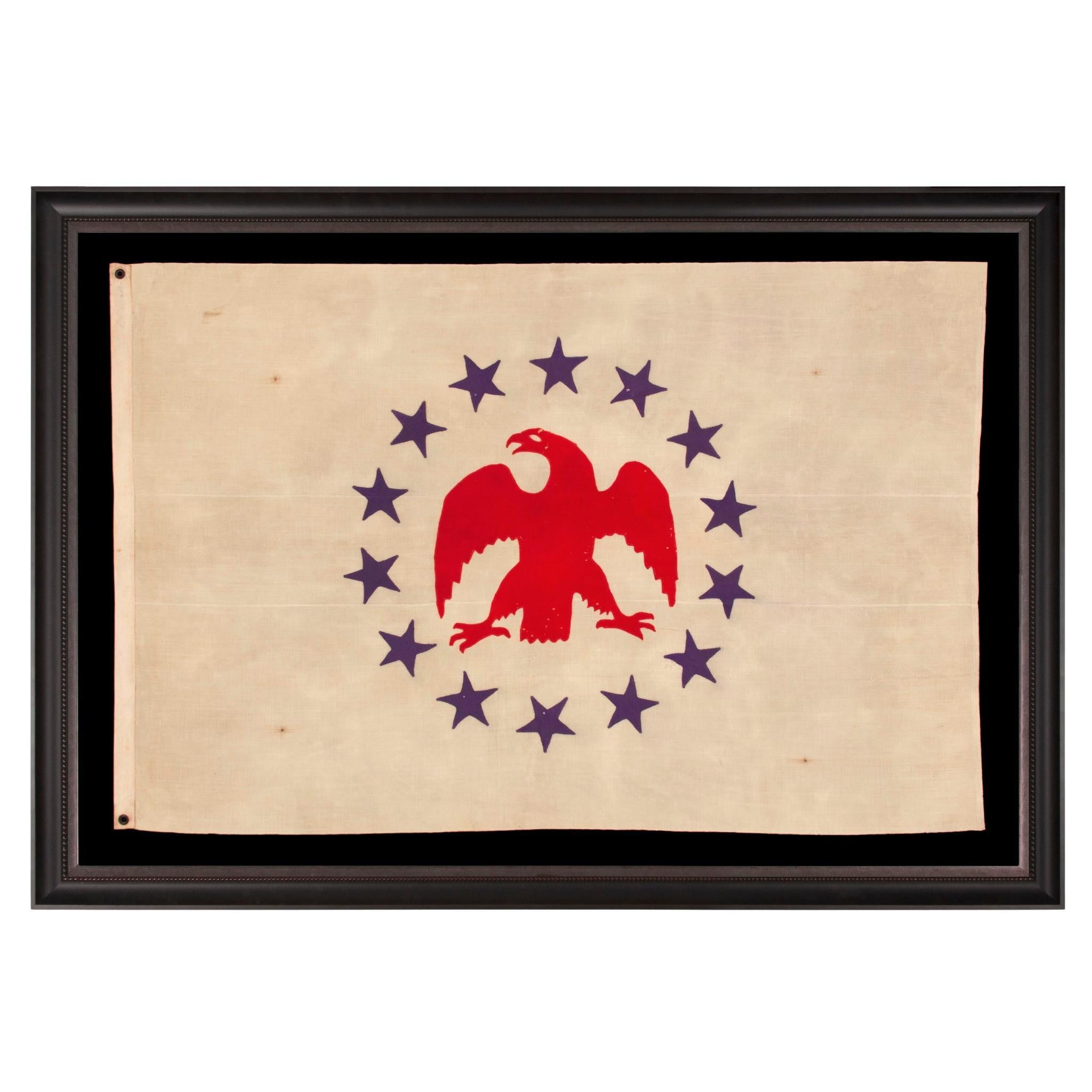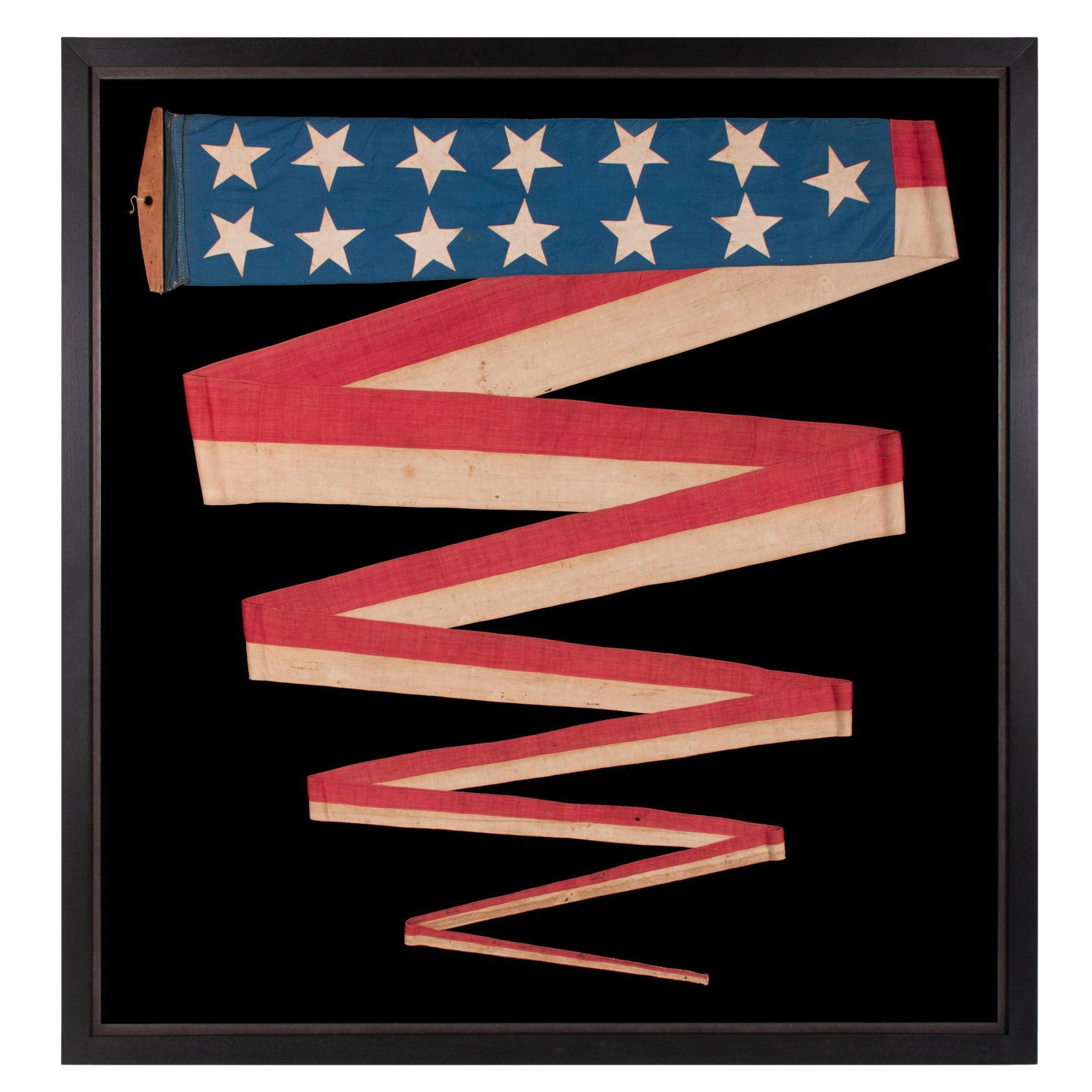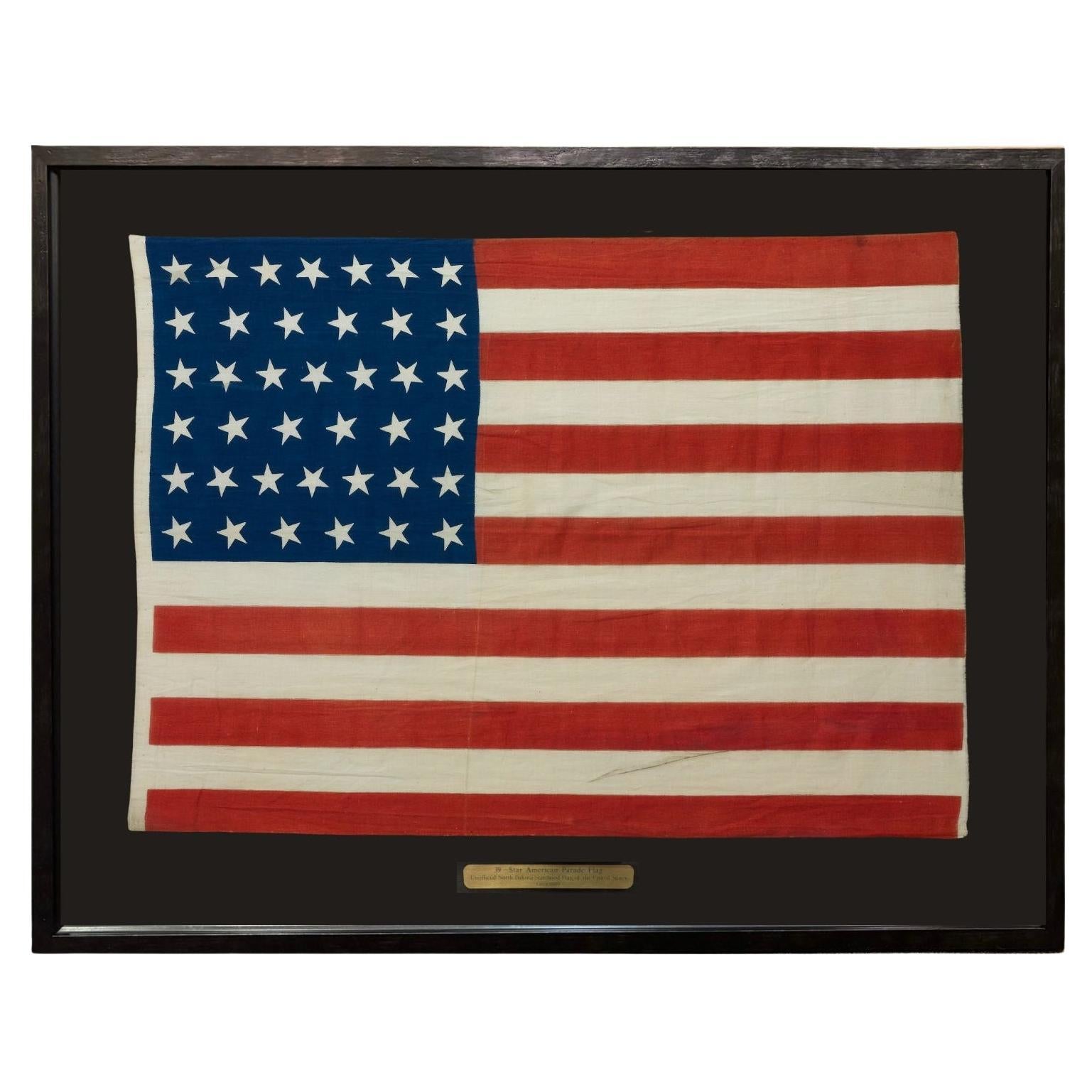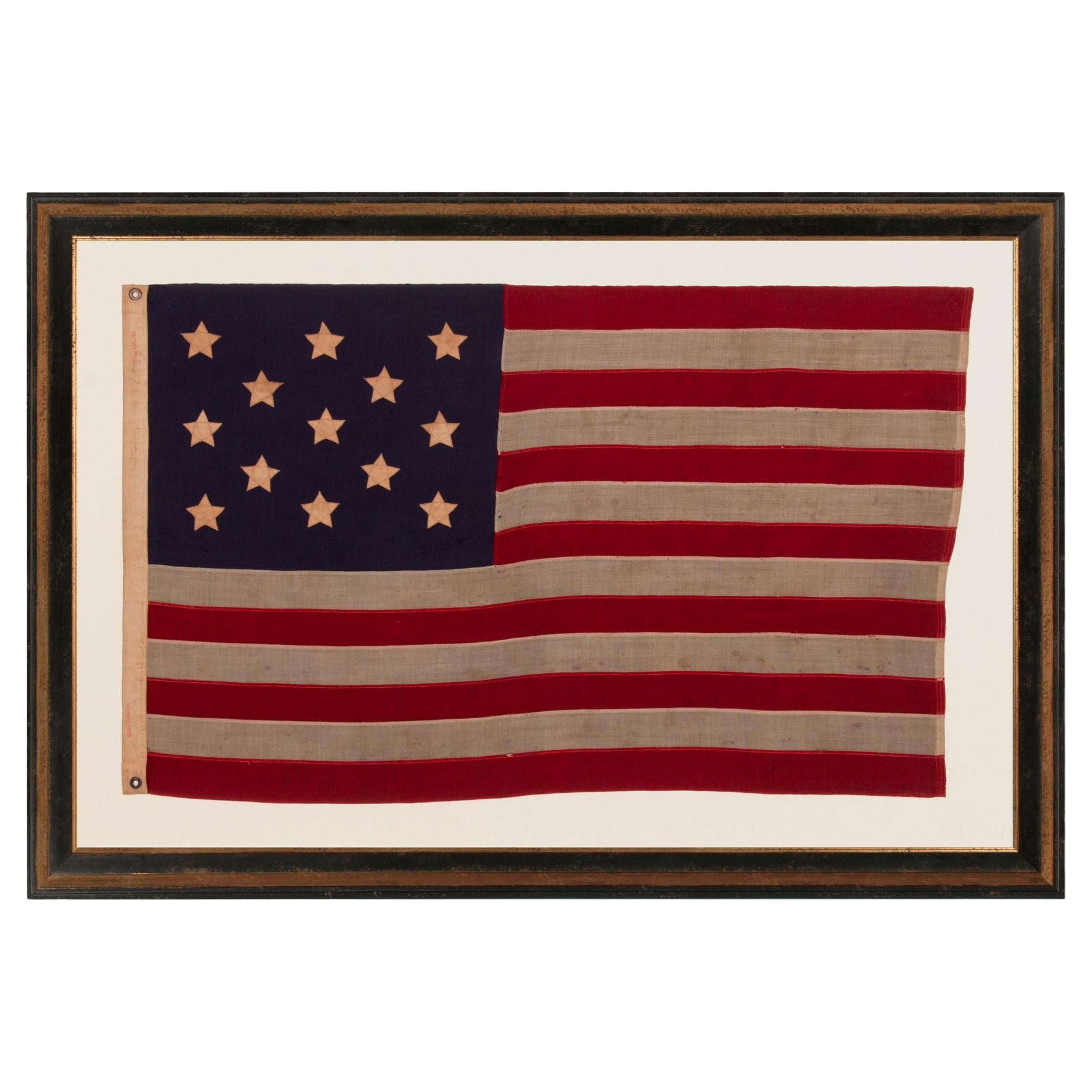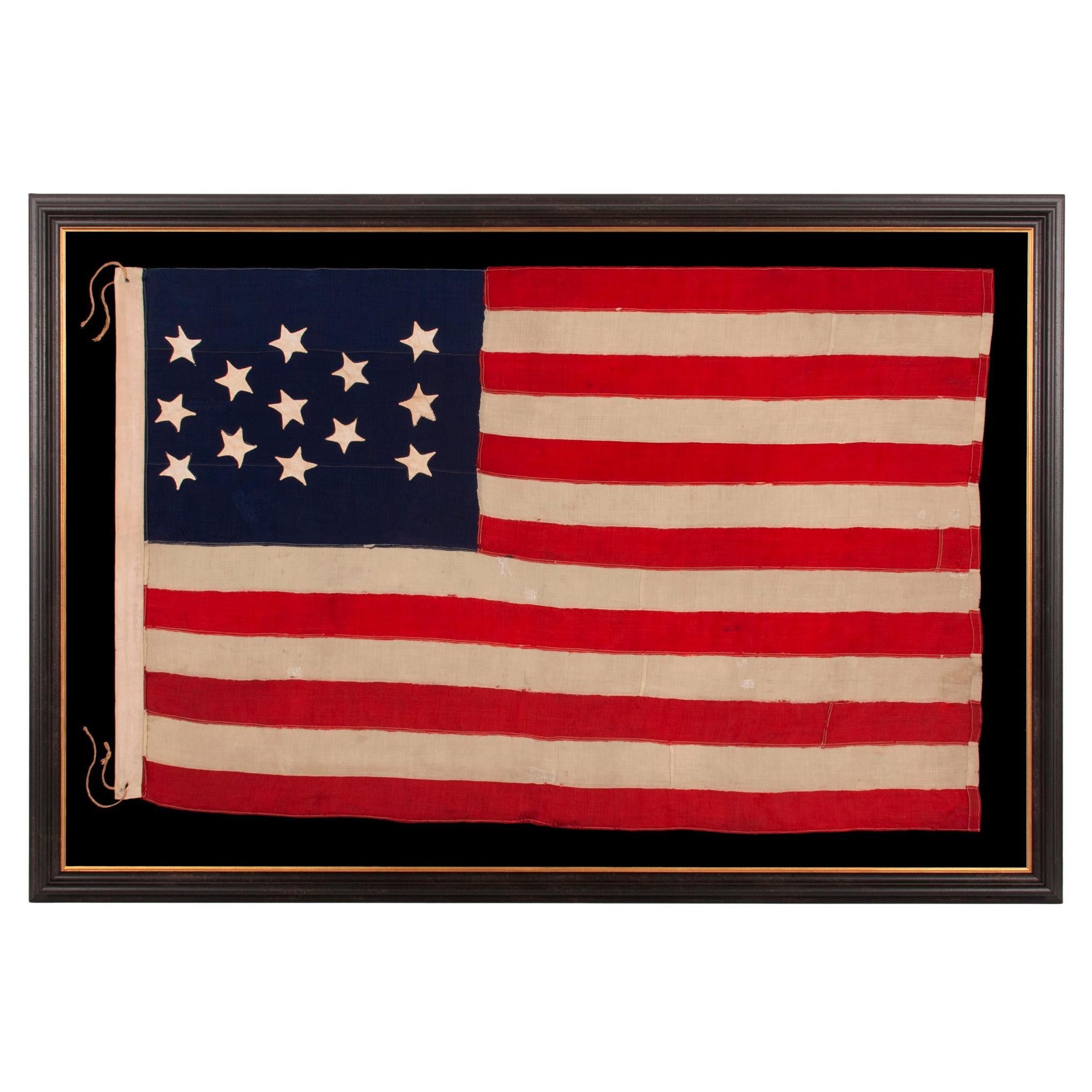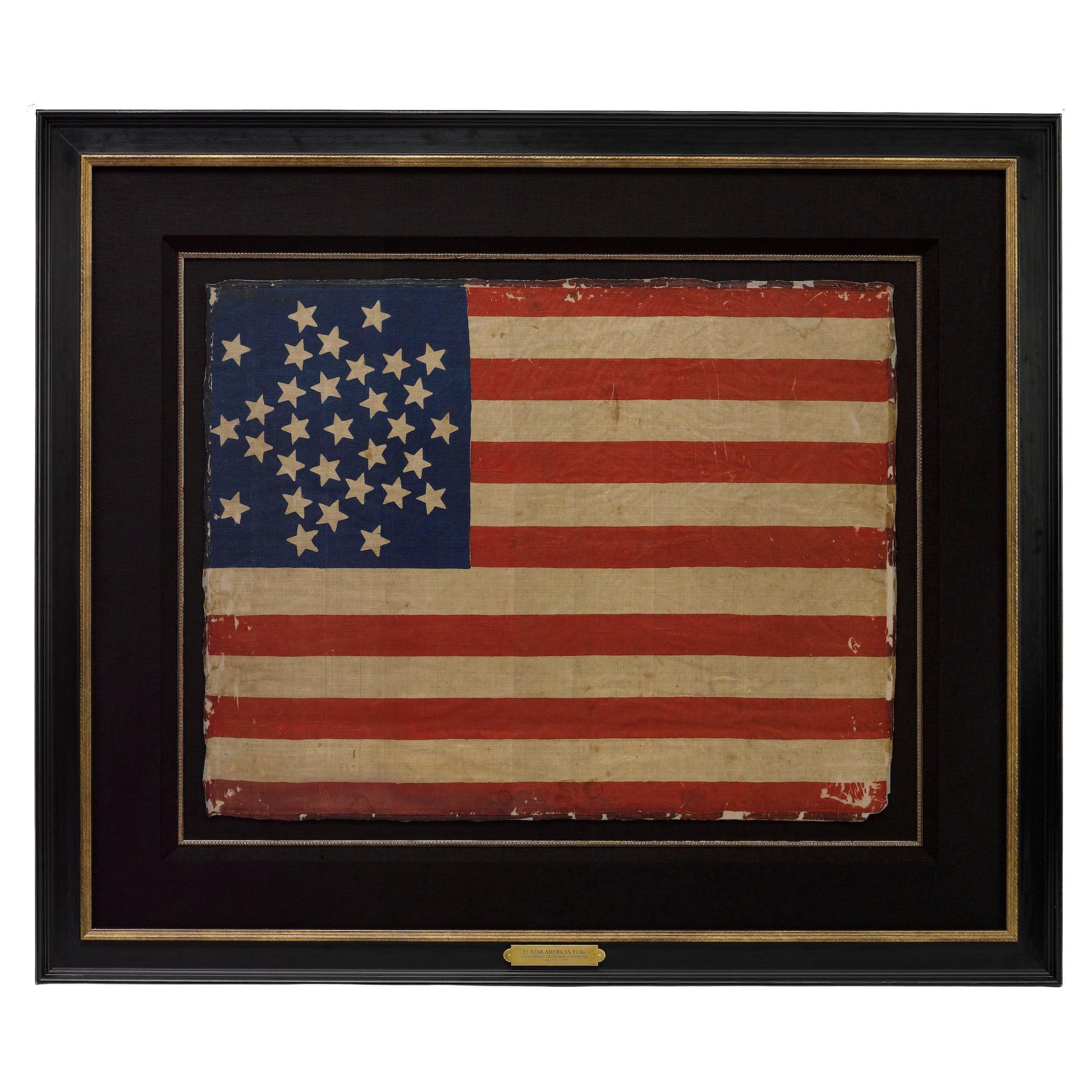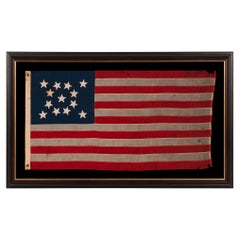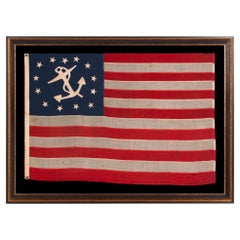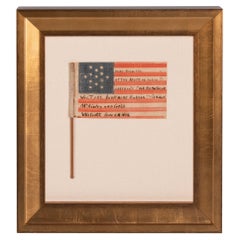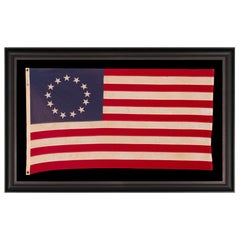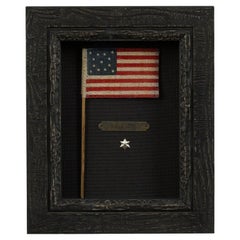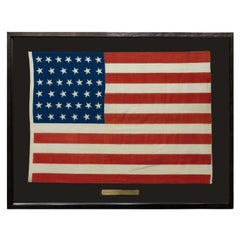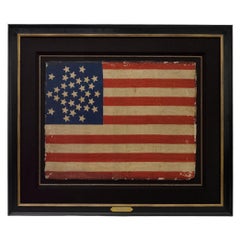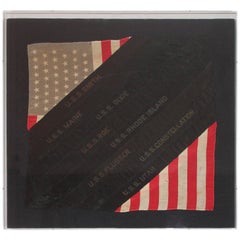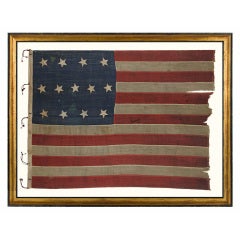
Entirely Hand-Sewn, 13 Star Flag in the 4-5-4 Pattern, 1850-63
View Similar Items
Want more images or videos?
Request additional images or videos from the seller
1 of 6
Entirely Hand-Sewn, 13 Star Flag in the 4-5-4 Pattern, 1850-63
About the Item
Entirely hand-sewn, 13 star American national flag. This is a probably a U.S. Navy small boat ensign, made sometime between 1850 and the opening years of the Civil War (1861-1863); probably the latter, since production increased with the need driven by war. Small boat ensigns were sometimes flown at the stern, from a gaff, or from the yard-arm on a larger vessel, or as the primary flag on a skiff or other small craft that carried sailors back and forth to shore.
The 4-5-4 lineal configuration is both scarcer and more appealing than rows of stars in counts of 3-2-3-2-3, and is generally seen on flags made during the Civil War period and prior. For some reason the 4-5-4 pattern was not popular during the celebration of our nation?s 100-year anniversary of independence in 1876, or thereafter, so it is both desired and more interesting than some other 13 star designs. It is sometimes seen in the 1890?s on small-scale 13 star flags produced by commercial makers, but these are scarce. There was no official star pattern for the 13 star flag set forth in the flag act of June 14th, 1777, and because the original does not survive, nor are descriptions of it recorded in public documents or private journals, no one actually knows what the very first one looked like. Due to its apparent popularity in early America, however, as evidenced by both drawings and surviving 19th century examples, more than one flag expert has hedged that lineal rows of 4-5-4 was probably the original configuration.
The flag is entirely hand-sewn. The stars are made of cotton and double-appliquéd. This means that they were applied to both sides of the blue wool canton. Note how the stars point in various directions on their vertical axis, which adds a nice level of folk quality to the flag's presentation. The canton and stripes are made of wool bunting. There is a heavy linen or coarsely woven canvas binding along the hoist with two, tiny, hand-sewn, whip-stitched grommets, one each at the top and bottom. Additional holes were pierced at some point so that red wool ties could be added, not only through the two grommets, but at three points in-between. The ties are unusual and provide evidence that the flag was carried on foot. Ties like these are not often used at sea. They also contribute nicely to the visual impact of this great, small-scale flag.
The letter "C" has been stenciled along the hoist in black ink in three places. This probably denotes the first initial of the last name of the captain or the name of the ship. It could also indicate size, so that the correct flag could be selected from a folded group, although this so of marking was usually numeric.
Adding considerably to the appeal of this flag is its small size when compared to others made during the 19th century. In modern times, this flag might even be considered large, but prior to the 1890?s however, it is extremely small when compared to its counterparts with sewn construction. Printed parade flags (sometimes called hand-wavers) were generally three feet long or smaller, but flags with sewn construction were generally eight feet long and larger. This is because flags needed to be seen from a distance to be effective in their purpose as signals, while today their use is more often decorative and the general display of patriotism. In the 19th century, even those flags made for decorative purpose were often large by today?s standards, so the average 19th century sewn flag can be cumbersome to frame and display in an indoor setting. This is why many collectors prefer printed parade flags and smaller sewn flags, like this one.
The most common variety of U.S. Navy small boat flag measured about 6 feet in length. This one is currently about 38.5" x 50". Since Naval flags were customarily long and narrow, this particular example was certainly longer originally, probably measuring 6 feet on the fly. An elongated format was more practical for nautical use, both because it allowed for the fly end to be turned back and hemmed many times to repair losses sustained during windy use at sea, and so that a greater size could be displayed on a shorter amount of vertical space.
13 star flags have been used throughout our Nation?s history for a variety of purposes. The U.S. Navy used the 13 star count on small boats, not only in the 18th century, but throughout much or all of the 19th century, particularly the second half. Ship captains were paranoid about the ability of foreign ships to recognize the flag on the open seas. On small flags in particular, viewed through a spyglass at a distance, the ability discern individual stars was of great concern. Keeping the count at 13 maintained better visibility and consistency. The practice theoretically ended in 1916 following an executive order from then-President Woodrow Wilson, though old military traditions die hard and according to at least one expert, Wilson?s order did not completely dispel the presence of 13 star flags on U.S. Navy craft.
Some private ships flew 13 star flags during the same period as the Navy, and the use of yachting ensigns with a wreath of 13 stars surrounding an anchor, which began in 1848, still persists today. Among other uses, 13 star flags were carried by soldiers during the Mexican and Civil Wars and displayed at various patriotic events, including Lafayette?s final visit to the U.S. in 1825-26, the celebration of the Nation's centennial of independence in 1876, and the sesquicentennial in 1926.
Mounting: The flag has been hand-stitched to 100% natural fabrics for support on every seam and throughout the star field. Fabrics of similar coloration were chosen to mask losses and strengthen its color against the light background. The flag was then hand-stitched to a background of 100% hemp fabric. The mount was then placed in a black-painted, hand-gilded and distressed Italian molding. The glazing is U.V. protective acrylic.
Condition: The fly end of the flag has been significantly shortened during the course of its use as a customary and proper means of repair. There are minor holes throughout from obvious use and moderate soiling. Many of my clients prefer early flags to show their age.
- Place of Origin:
- Period:
- Date of Manufacture:1850-1863
- Condition:See Item Description.
- Seller Location:York County, PA
- Reference Number:Seller: 13j-11941stDibs: U1202208497538
About the Seller
5.0
Recognized Seller
These prestigious sellers are industry leaders and represent the highest echelon for item quality and design.
Established in 1991
1stDibs seller since 2008
69 sales on 1stDibs
Typical response time: 1 to 2 days
Authenticity Guarantee
In the unlikely event there’s an issue with an item’s authenticity, contact us within 1 year for a full refund. DetailsMoney-Back Guarantee
If your item is not as described, is damaged in transit, or does not arrive, contact us within 7 days for a full refund. Details24-Hour Cancellation
You have a 24-hour grace period in which to reconsider your purchase, with no questions asked.Vetted Professional Sellers
Our world-class sellers must adhere to strict standards for service and quality, maintaining the integrity of our listings.Price-Match Guarantee
If you find that a seller listed the same item for a lower price elsewhere, we’ll match it.Trusted Global Delivery
Our best-in-class carrier network provides specialized shipping options worldwide, including custom delivery.More From This Seller
View All13 Star Antique American Flag , Hand-Sewn Stars in a Medallion, 1876 Centennial
Located in York County, PA
13 STAR ANTIQUE AMERICAN FLAG WITH A MEDALLION CONFIGURATION OF HAND-SEWN STARS AND A BEAUTIFUL, ELONGATED PROFILE, MADE IN THE ERA OF THE 1876 CENTENNIAL OF AMERICAN INDEPENDENCE, I...
Category
Antique 1870s Political and Patriotic Memorabilia
Materials
Wool
Outstanding 13 Star Hand-sewn American Private Yacht Flag, ca 1865-1885
Located in York County, PA
OUTSTANDING, 13 STAR, ANTIQUE AMERICAN PRIVATE YACHT ENSIGN WITH GREAT FOLK QUALITIES THAT INCLUDE AN UNUSUALLY WIDE ANCHOR AND A DECIDEDLY LOPSIDED RING OF 13 STARS; MADE DURING THE 2ND HALF OF THE 19TH CENTURY; ITS DEVICE HAND-SEWN AND SINGLE-APPLIQUÉD
Private yacht ensigns were approved American signals for maritime use that allowed pleasure boats to bypass customs. Though the legislation that approved them was adopted prior to 1850, almost all such flags that one will encounter were sewn by electric machine and made during the 20th century. The unusual gems among surviving examples are those that are earlier and include hand-sewn elements. Even more rare are a select few with atypical graphics. Barely any fall into both of these categories at once. Take note of the anchor on this particular flag, wide a long horizontal crossbar (stock) that contributes to uncommonly wide stance. Set within a ring of stars that is decidedly lopsided, the result is as bold as it is endearingly whimsical—two of the best qualities in American folk art, a category in which this particular example can be filed. While I have owned 13 star private yacht flags that have displayed star and canted anchor devices that were somewhat larger and/or bolder than typical, I cannot recall any that were so graphically intriguing as this one.
Brief History of Private Yacht Ensigns:
The medallion configuration, 13-star, 13-stripe flag, with a canted center anchor was entered into official use in 1848, following an act of Congress, that made it the official signal for U.S. pleasure sailing vessels. The need for such a flag arose with the popularity of boating as a pastime for well-to-do Americans, and as a competitive sport, in addition to its longstanding utilitarian role as a vehicle of trade. In early America, all boats were subject to customs searches at every port. Without modern income tax, the federal government derived its revenues mostly from tariffs, so an accounting of foreign goods on ships was a critical venture. As yachting for pleasure became more prevalent, however, more and more time was spent searching boats that had no such inventory, wasting time for both customs officials and wealthy ship owners.
John Cox Stevens, a former president of the Jockey Club and future founder of the Union League Club, became the New York Yacht Club’s Commodore upon its founding in 1845. In 1847 he approached the secretary of the treasury and suggested that something be done to streamline the customs process for non-trade vessels. In 1848, legislation passed Congress requiring registration of these boats, which could then fly the “American Yachting Signal” to bypass customs. This remained on the books until the 1980’s, when the 1848 legislation was revoked, but the use of flags in this design for decorative function continues to this day.
13 star flags have been flown throughout our nation’s history for a variety of purposes. In addition to their use on private yachts, they were hoisted at patriotic events, including Lafayette’s final visit in 1824-25, the celebration of the nation’s centennial in 1876, and the sesquicentennial in 1926. They were displayed during the Civil War, to reference past struggles for American liberty and victory over oppression, and were used by 19th century politicians while campaigning for the same reason. The U.S. Navy used the 13 star count on small boats until 1916, because it was easier to discern fewer stars at a distance on a small flag. Commercial flag-makers mirrored this practice and some private ships flew 13 star flags during the same period as the Navy.
Construction: The stars and anchor are made of cotton, hand-sewn, and single-appliquéd. This means that they were applied to one side of the canton, then the blue fabric was cut from behind each star, folded over, and under-hemmed, so that one star could be viewed on both sides of the flag. I always find single-appliquéd stars more interesting, not only because they are evidence of a more difficult level of seam-work and stitching, but also because they are more visually intriguing. The two visible rows of hand-stitching emphasize their hand-sewn construction. For these reasons, single-appliquéd stars often appeal to connoisseurs of early American textiles...
Category
Antique Mid-19th Century American Political and Patriotic Memorabilia
Materials
Wool
Price Upon Request
13 Star Antique Parade Flag, Hand Inscribed by the Owner in Salem, MA 1896
Located in York County, PA
ANTIQUE AMERICAN FLAG WITH 13 STARS ARRANGED IN 6-POINTED GREAT STAR / STAR OF DAVID PATTERN, OF A TYPE MADE FOR THE 1876 CENTENNIAL OF AMERICAN INDEPENDENCE, WORN AND HAND-INSCRIBED...
Category
Antique 1870s American Political and Patriotic Memorabilia
Materials
Cotton
13 Star, Betsy Ross Pattern Flag, Made by the Annin Company, ca 1955-1965
Located in York County, PA
13 STARS IN THE BETSY ROSS PATTERN, ON A VINTAGE AMERICAN FLAG, MADE BY THE ANNIN COMPANY OF NEW YORK & NEW JERSEY, circa 1955 - 1965
13 star American national flag, made entirely of cotton by the Annin Company of New York & New Jersey, in the period between approximately 1955-1965. The stars are arranged in the circular wreath pattern most often associated with Betsy Ross. Flags in this design are widely admired, due to the longstanding popularity of the Ross family myth. While many Americans were taught in grammar school that this was what our first flag looked like, there is, unfortunately, no way to substantiate the claim, and no colonial flags...
Category
Late 20th Century American Political and Patriotic Memorabilia
Materials
Cotton
38 Star American Parade Flags with Stars in a Great Star Pattern
Located in York County, PA
38 STAR AMERICAN PARADE FLAG WITH A RARE AND BEAUTIFUL VARIATION OF THE “GREAT STAR” OR “GREAT FLOWER” PATTERN, 4 LARGE CORNER STARS, & AN ODD OUTLIER, 1876-1889, COLORADO STATEHOOD,...
Category
Antique Late 19th Century American Political and Patriotic Memorabilia
Materials
Silk
Price Upon Request
14 Star, Hand-Sewn Flag with Appliqued Eagle, Made by Sarah McFadden, ca 1852-73
Located in York County, PA
ENTIRELY HAND-SEWN FLAG WITH AN APPLIQUED FEDERAL EAGLE AND 14 STARS, MADE IN THE 1850’s BY RENOWNED FLAG MAKER SARAH McFADDEN, “THE BESTY ROSS OF NEW YORK,” FOR THE HUDSON RIVER STE...
Category
Antique Mid-19th Century American Political and Patriotic Memorabilia
Materials
Cotton
You May Also Like
13-Star Flag Waver for the Centennial Celebration
Located in Colorado Springs, CO
This small charming 13-star flag waver was made for and sold during the nation’s Centennial celebration in Philadelphia in 1876. All manner of flags were made for the official Centen...
Category
Antique 1870s American Political and Patriotic Memorabilia
Materials
Fabric
39-Star Antique American Flag with 'Whimsical' Star Pattern, 1889
Located in Colorado Springs, CO
This is a 39-star unofficial American flag, handmade and printed on cotton. The flag dates to 1889 and has a unique history, thanks to its rare star-count.
The flag’s canton is prin...
Category
Antique 1880s American Political and Patriotic Memorabilia
Materials
Cotton
31-Star Printed American Flag, Celebrating California Statehood, Circa 1850
Located in Colorado Springs, CO
This is a rare 31-star medallion printed American flag, celebrating the addition of California to the Union. The flag is printed on silk and has a spectacular “Great Star” canton pat...
Category
Antique 1850s American Political and Patriotic Memorabilia
Materials
Silk
Framed Hand Sewn Patriotic Sham Made from a Flag and Ship Ribbons
Located in Los Angeles, CA
This Great framed Folk Art sham with 48star flag and ship ribbons is a great patriotic item. The top left corner as well as the bottom right corner are scraps of a 48 star linen flag and in between them are ribbons of ships names that are sewn together in a collage. The American ships span three centuries of ships ribbons, from late 19th century to present day ships. As well as the "USS Utah" which was sunk during the attack on Pearl Harbor.
This great and proud sham is not only a great American item but is a Symbol of hope and unity throughout the ages. Serves better as a hanging Folk Art...
Category
20th Century American Folk Art Political and Patriotic Memorabilia
Materials
Plexiglass
$1,356 Sale Price
20% Off
46-Star American Flag Printed in Drum Star Configuration
Located in Colorado Springs, CO
This is an original 46-Star American parade flag, celebrating Oklahoma statehood. Each star on the flag's canton represents a state in the Union at the time. The official flag design would update every July 4th, to include any new states added to the Union in the past year. Oklahoma, the 46th state, entered the Union on November 16, 1907. As such, this 46–star flag was the official flag of the United States from July 4, 1908, until July 4, 1912.
The silk flag has a dark blue canton with 46 white printed stars. The stars are printed in an 7-8-8-8-8-7 row configuration, or “Drum design.” The flag design is completed with 13 alternating red and white stripes, each stripe representing one of the original thirteen colonies.
The land that comprises Oklahoma today was added to the United States as part of the Louisiana Purchase of 1803. Throughout the 19th century, the U.S. government relocated Indian tribes from the southeastern United States to the area, and by 1900, over 30 Indian tribes had been moved to what was originally called the Indian Territories. At the same time, ranchers in Texas began to move into the area in search of new pasture lands. Although stipulations in the Indian Relocation Act agreed that the land would forever be Indian Territory, the promise of fertile farmland trumped the government’s promise of sovereignty.
On April 22, 1889, they opened the land to settlement by homesteaders, creating a land run in which settlers, called “Boomers,” were allowed to cross the Texas or Arkansas border at a particular hour to claim homesteads. Settlers who illegally crossed the border earlier to stake prime land were called “sooners,” which eventually became the state’s nickname. Wagons and the Santa Fe railroad carried cartloads of men and women to blank town sites and building plots, creating ten thousand-people communities in a matter of days. The following year, the region was further divided into Indian Territory and Oklahoma Territory...
Category
Vintage 1910s American Political and Patriotic Memorabilia
Materials
Silk
Early 20thc 48 Star Flag Hand Crochet Pillow
Located in Los Angeles, CA
This fine hand crochet 48 star flag pillow is made with a blue velvet background or frame front and back.The insert is down & feather fill.
Category
Early 20th Century American Adirondack Pillows and Throws
Materials
Wool
$556 Sale Price
20% Off
Recently Viewed
View AllMore Ways To Browse
Antique Yard Long
Sea Captains 19th
Antique Spyglass
First Nation Masks
Hemp Drawing
Used Skiffs
Antique Mexican Flag
Framed American Flag 50 Star
General Lafayette
13 Star With 4 5 4 Star Pattern
50 Star Flag
Nautical Signal Light
Navy Signal Light
Antique Sake Set
Political Campaign Memorabilia
Boat Machine
Wwi Memorabilia
Medallion Applique
